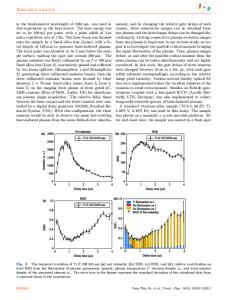Effect of ambiance on the coal characterization using laser-induced breakdown spectroscopy (LIBS)
- PDF / 1,416,060 Bytes
- 10 Pages / 595.276 x 790.866 pts Page_size
- 70 Downloads / 289 Views
S.I. : CURRENT STATE-OF-THE-ART IN LASER ABLATION
Effect of ambiance on the coal characterization using laser‑induced breakdown spectroscopy (LIBS) Hemalaxmi Rajavelu1 · Nilesh J. Vasa1 · Satyanarayanan Seshadri2 Received: 15 October 2019 / Accepted: 16 April 2020 © Springer-Verlag GmbH Germany, part of Springer Nature 2020
Abstract The influence of surrounding gases, such as He, N2, atmospheric air, and Ar, and gas flow rate on the laser-induced breakdown spectroscopy (LIBS) characterization of coals in free space is studied. The atomic and molecular carbon ( C2 and CN) emission intensities are observed to be higher in Ar and N 2 ambiance. Quantitative analysis of carbon and ash content in different coal samples is carried out using the carbon bound atomic and molecular emission signals and the ash forming elements (Si, Fe, Mg, Al, Ca, Na, and K) signals. The sum of the LIBS emission of the all and major ash forming elements increased linearly with an increase in the ash content. Similarly, the ratio between the carbon signals (C I, CN, and C2) and the sum of major ash forming elements (Si, Al, Fe, and Ca) also showed a linear increase with the increase in carbon content in coal samples. The linear coefficient of regression, R 2, was estimated to be 0.67, 0.58, and 0.85, and the root mean square of calibration samples was estimated to be 5.71, 5.82, and 5.57 wt% using the partial least square regression (PLSR) method for air (no flow), N 2, and Ar atmosphere, respectively. The precision and accuracy of the carbon measurement in coal samples by the LIBS technique using the PLSR method were higher in the presence of Ar than air or N2 atmosphere due to the plasma shielding effect. Keywords LIBS · Coal · Coal ash · Elemental analysis · Gas flow
1 Introduction The chemical composition of coal has a significant impact on coal-fired thermal power plants and boiler performance, where the physical and chemical behavior of coal can influence the combustion process [1]. Ultimate and proximate analyses are the current state of the art for analyzing the composition, which is an off-line and time-consuming process (often, the analysis can take up to 8 h) [2]. Other techniques like X-ray fluorescence spectroscopy (XRF) and prompt gamma neutron activation analysis (PGNAA) can provide fast online analysis [3, 4]. However, XRF cannot detect light elements, and PGNAA requires strict safety * Nilesh J. Vasa [email protected] Hemalaxmi Rajavelu [email protected] 1
Department of Engineering Design, Indian Institute of Technology Madras, Chennai 600036, India
Department of Applied Mechanics, Indian Institute of Technology Madras, Chennai 600036, India
2
regulations because of the radioactive neutron source. Alternatively, laser-induced breakdown spectroscopy (LIBS), which uses pulsed laser ablation to form plasma over the target surface and involves optical emission-based measurements, can also be considered for the elemental analysis. LIBS technique is the better choice for online coal monitoring as it o
Data Loading...











